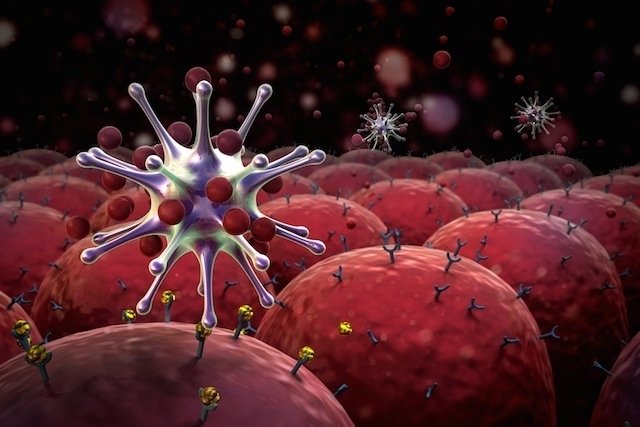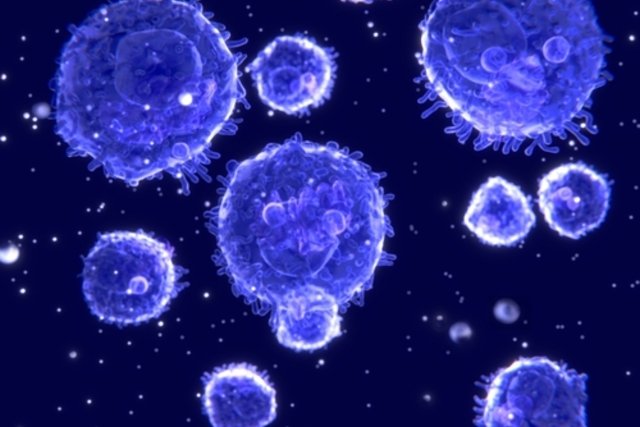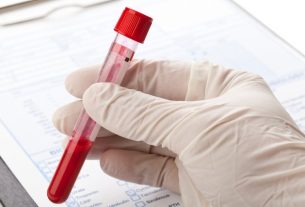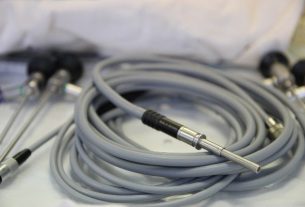Lymphocytes are a type of defense cell in the body, also known as white blood cells, which are produced in greater quantities when there is an infection, and are therefore a good indicator of the patient’s health status. There are two types of lymphocytes, B cells and T cells, which perform different functions in the immune system.
The number of lymphocytes can be assessed through a blood test, so when they are increased it is normally indicative of infection, while a decrease in the number of lymphocytes may be related to some change in the bone marrow.
Therefore, it is important that the blood test is evaluated by the doctor so that it is possible to assess the person’s general health status and relate the results obtained with the clinical history, so that it is possible to make the diagnosis and initiate the most appropriate treatment, if necessary.

Altered lymphocytes
The normal reference values for lymphocytes are between 1000 and 3900 lymphocytes per mm³ of blood, which represents 20 to 50% in the relative count, and may vary according to the laboratory in which the test is carried out. When values are above or below the reference value, lymphocytosis or lymphopenia, respectively, is characterized.
Do you have questions about your exam results?
The number of lymphocytes above reference values is called lymphocytosis and is normally related to infectious processes. Thus, the main causes of high lymphocytes are:
- Acute infections, such as mononucleosis, polio, measles, rubella, dengue or whooping cough, for example;
- Chronic infections, such as tuberculosis, malaria;
- Hepatitis viral;
- Hyperthyroidism;
- Pernicious anemia, which is characterized by a deficiency of folic acid and vitamin B12;
- Benzene and heavy metal poisoning;
- Diabetes;
- Obesity;
- Allergy.
Furthermore, an increase in the number of lymphocytes can also occur due to physiological situations, such as pregnant women and infants, as well as nutritional deficiencies, such as vitamin C, D or calcium deficiency.
2. Low lymphocytes
The number of lymphocytes below reference values is called lymphopenia and is normally related to situations involving the bone marrow, such as aplastic anemia or leukemia. Furthermore, lymphopenia can also be a sign of autoimmune diseases, in which the body itself acts against the immune defense system, such as systemic lupus erythematosus (SLE), for example. Learn more about lymphopenia.
Lymphopenia can also occur due to AIDS, therapy with immunosuppressive drugs or chemotherapy or radiotherapy treatment, rare genetic diseases, or be a consequence of stressful situations, such as post-surgery and body overload, for example.
The decrease in lymphocyte values may also be a consequence of COVID-19, in which the presence of the virus in the body can lead to the destruction of lymphocytes. However, to confirm COVID-19, other blood tests are necessary, in addition to a positive result in the molecular test. Understand how COVID-19 is diagnosed.
How to know if lymphocytes are normal
To find out if your lymphocytes are normal, enter your test results into the calculator below:
Types of lymphocytes
There are 2 main types of lymphocytes in the body, B lymphocytes, which are immature cells produced in the bone marrow and released into the bloodstream to produce antibodies against bacteria, viruses and fungi, and T lymphocytes, which are produced in the bone marrow but which They are then developed in the thymus until they are divided into 3 groups:
- CD4 T lymphocytes: They help B lymphocytes eliminate infections, being the immune system’s first alert. These are normally the first cells to be affected by the HIV virus, and in infected patients the blood test indicates a value below 100/mm³.
- CD8 T lymphocytes: decrease the activity of other types of lymphocytes and, therefore, are increased in cases of HIV;
- Cytotoxic T lymphocytes: destroy abnormal cells infected by viruses or bacteria.
However, lymphocyte type tests, especially the CD4 or CD8 type, should always be interpreted by a doctor to assess whether there is a risk of having HIV, for example, since other diseases can also cause the same type of changes.
Therefore, if there is any doubt about being infected with HIV, it is advisable to take a laboratory test that looks for the virus inside the body’s cells. Learn more about HIV testing.
What are atypical lymphocytes?
Atypical lymphocytes are lymphocytes that have a varied shape and that normally appear when there are infections, mainly viral infections, such as mononucleosis, herpes, AIDS, rubella and chickenpox. In addition to appearing in viral infections, atypical lymphocytes can be identified in the blood count when there is a bacterial infection, such as tuberculosis and syphilis, protozoal infection, such as toxoplasmosis, when there is hypersensitivity to drugs or in autoimmune diseases, such as lupus.
Normally the number of these lymphocytes returns to normal (reference value for atypical lymphocytes is 0%) when the agent causing the infection is eliminated.
These lymphocytes are considered activated T lymphocytes that are produced in response to infected type B lymphocytes and perform the same functions as typical lymphocytes in the immune response. Atypical lymphocytes are generally larger than normal lymphocytes and variable in shape.
Bibliography
- BRAZILIAN SOCIETY OF CLINICAL ANALYSIS. Laboratory changes in patients with Covid-19. Available at: <https://www.sbac.org.br/blog/2020/03/26/alteracoes-laboratoriais-em-pacientes-com-covid19/>. Accessed on March 16, 2021
- MEDICAL NEWS TODAY. What are lymphocytes and what are healthy levels to have?. Available at: <https://www.medicalnewstoday.com/articles/320987.php>. Accessed on October 4, 2019
- NATIONAL QUALITY CONTROL PROGRAM. Normal CBC Values. Available at: <http://www.pncq.org.br/uploads/2012/06/valores_normal_hemograma.pdf>. Accessed on October 4, 2019
- MALE, David; BROSTOFF, Jonathan; ROTH, David B.; ROITT, Ivan M. Immunology. 8.ed. Rio de Janeiro: Elsevier, 2014. 3-17.
- ROCHA, Arnaldo. Biodiagnostics: fundamentals and laboratory techniques. São Paulo: Rideel, 2014. 13-35.
- LAROSA, D.F.; ORANGE, J.S. Lymphocytes. The Journal of Allergy and Clinical Immunology. 121(2). S364–S369, 2008

Sign up for our newsletter and stay up to date with exclusive news
that can transform your routine!
Warning: Undefined array key "title" in /home/storelat/public_html/wp-content/plugins/link-whisper-premium/templates/frontend/related-posts.php on line 12
Warning: Undefined array key "title_tag" in /home/storelat/public_html/wp-content/plugins/link-whisper-premium/templates/frontend/related-posts.php on line 13




